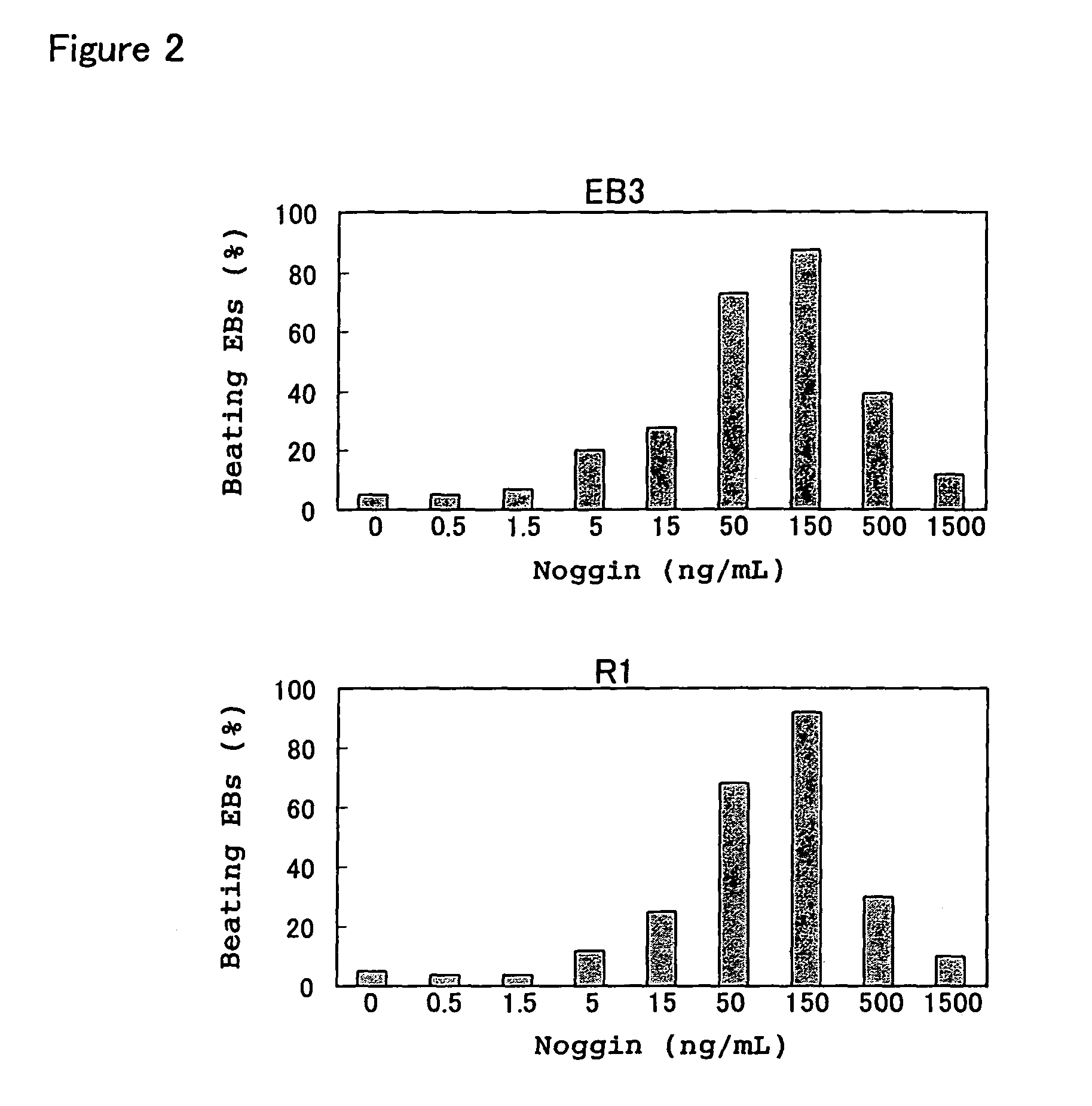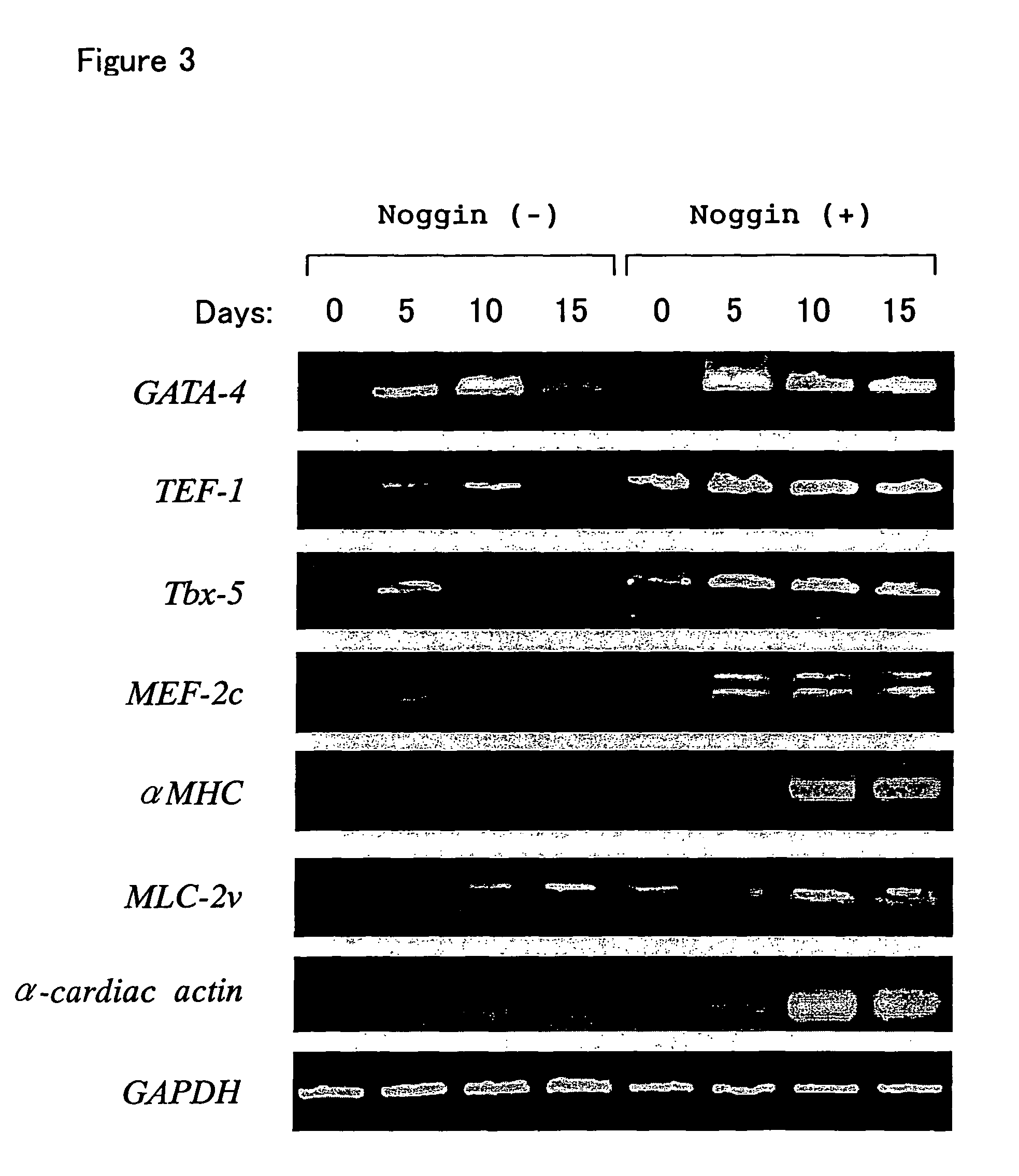Method of inducing the differentiation of stem cells into myocardial cells
a stem cell and myocardial cell technology, applied in the field of stem cell differentiation into myocardial cells, can solve the problems of heart failure, cardiac function lowering, cardiomyocyte loss cannot be replaced, etc., and achieve the effect of efficient and selective production
- Summary
- Abstract
- Description
- Claims
- Application Information
AI Technical Summary
Benefits of technology
Problems solved by technology
Method used
Image
Examples
example 1
Effects of Noggin Treatment on Cardiomyocyte-Differentiation from ES Cells
[0133]The effects of addition of the Noggin protein to culture medium on the development of cardiomyocytes were studied in an experimental system in which EBs were formed by floating aggregation culture (called simply floating culture in the examples of this application below) of ES cells and induced to differentiate into cardiomyocytes.
[0134]In the experiments below, EB3 cells (provided by Prof. Hitoshi Niwa of Riken, Japan), R1 cells (provided by Andrew Nagy of Mount Sinai Hospital, Canada) and 129SV cells (purchased from Dainippon Pharmaceutical Co.) were used as the ES cells, but in general there were no differences between these ES cell lines. These ES cells were passaged and maintained in an undifferentiated state according to the methods described in Manipulating the Mouse Embryo: A Laboratory Manual (Hogan et al Eds., Cold. Spring Harbor Laboratory Press, 1994), Embryonic Stem Cells: Methods and Protoc...
example 2
Properties of Cardiomyocytes Derived from Noggin-Treated ES Cells
[0142]As shown in Example 1, beating of EBs prepared from ES cells was increased significantly by Noggin treatment, and to confirm that the beating cells in these EBs were cardiomyocytes, we investigated the expression of various myocardial-specific marker genes and proteins.
[0143]Expression of various myocardial cell-specific marker genes in the Noggin (+) group and Noggin (−) group is shown in FIG. 3. EBs formed by floating culture as in FIG. 1 were collected periodically, and total RNA was prepared using RNeasy (Qiagen). Next, cDNA was reverse-transcribed by conventional methods using Superscript II (Invitrogen), and genes specific to cardiomyocytes were detected by polymerase chain reaction (PCR). The primers used to detect the transcripts of GATA-4, TEF-1, Tbx-5, MEF-2c, αMHC, MLC-2v, α-cardiac actin and GAPDH were as follows.
[0144]
GATA-4 (forward)5′-CTGTCATCTC ACTATGGGCA-3′(SEQ ID NO: 1)GATA-4 (reverse)5′-CCAAGTC...
example 3
Effects of Differences in Noggin Treatment Time and Period on Cardiomyocyte Differentiation from ES Cells
[0151]To determine the optimum time and period for Noggin treatment, the time of addition of the Noggin protein to the aforementioned floating culture system was varied, and the subsequent effects on myocardial differentiation induction were examined.
[0152]The results are shown in Table 1.
[0153]
TABLE 1Pre-differentiationDifferentiation-stageinducing stageAppearance ofNogginNogginBeating EBs−−++ 80%−++−
[0154]Table 1 shows the appearance rates of beating EBs (EB3 cell derived) under various culture protocols, indicating the importance of Noggin stimulus before and after EBs formation. In Table 1, “pre-differentiation stage” indicates culture conditions from 3 days before until the start of floating culture, while “differentiation-inducing stage” indicates culture conditions at the point of EBs formation. In Table 1, “+” indicates than Noggin (150 ng / mL) was added to the medium and...
PUM
| Property | Measurement | Unit |
|---|---|---|
| concentration | aaaaa | aaaaa |
| concentration | aaaaa | aaaaa |
| concentration | aaaaa | aaaaa |
Abstract
Description
Claims
Application Information
 Login to View More
Login to View More - R&D
- Intellectual Property
- Life Sciences
- Materials
- Tech Scout
- Unparalleled Data Quality
- Higher Quality Content
- 60% Fewer Hallucinations
Browse by: Latest US Patents, China's latest patents, Technical Efficacy Thesaurus, Application Domain, Technology Topic, Popular Technical Reports.
© 2025 PatSnap. All rights reserved.Legal|Privacy policy|Modern Slavery Act Transparency Statement|Sitemap|About US| Contact US: help@patsnap.com



